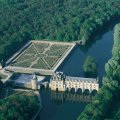This castle owes its fame above all to Diane de Poitiers, mistress of King Henry II.
The sumptuous architecture of the Château de Chenonceau is attributable to the great ladies of France who successively enriched it, making it one of the finest examples of French refinement. Marguerite Yourcenar wrote of this unforgettable château: "Its almost discreet charm is that of a private residence, and as chance would have it, it was above all a residence for women". Nicknamed the Château des Dames, it owes its fame above all to Diane de Poitiers, mistress of King Henri II. After her father's death in 1547, the young king gave the château to his favorite, who lived there for the next twelve years. Determined to leave an indelible mark of her passage, Diane de Poitiers transformed the château as we know it today. Indeed, it was she who undertook the construction of the famous bridge over the Cher, an architectural feat of the time. A keen horsewoman and hunting enthusiast, she commissioned the architect Philibert Delorme to create new gardens and expand her hunting grounds. When Catherine de Médicis became regent on the death of Henri II and reclaimed the château, she added two superimposed galleries and continued to embellish the gardens. Among the women who helped make Chenonceau one of the wonders of our heritage, we should also mention Louise Dupin, who in the 18th century invited writers and philosophers to the château and saved it during the French Revolution. In the following century, Marguerite Pelouze, who owned the property between 1864 and 1889, restored the château to its 16th-century splendor, even to the point of indebtedness. During the First World War, the monument was transformed into a hospital, under the aegis of Simone Menier, head nurse. And last but not least, the architect was a woman. Katherine Briçonnet supervised the construction of the château, financed by her husband Thomas Bohier's fortune, and made the architectural decisions while he was fighting with François I in the Italian wars.
Built to the plans of a Venetian palace, this stone colossus spanning the river is the only bridge-castle in the world. Its elegance is reflected in the rooms, all magnificently furnished and decorated. Tapestries and paintings by masters recall its splendid history, recounted throughout the tour by the audioguide. Among the château's most remarkable rooms are :
- The chapel: the original stained-glass windows were unfortunately destroyed during the Second World War, but a reproduction dating from 1954 can still be admired. The royal gallery overlooking the nave dates back to 1521. Thanks to Louise Dupin, who transformed it into a wood storehouse, the chapel was saved during the French Revolution.
- Diane de Poitiers' bedroom: the private quarters of King Henry II's favorite include a magnificent fireplace by Jean Goujon, later restored byMadame Pelouze, and two large 16th-century Flanders tapestries.
- The gallery: Connected by a passage to Diane de Poitiers' bedroom, the first floor gallery was inaugurated in 1577. It was here that Catherine de Médicis, who became regent on the death of her husband King Henri II, held her council. Note the length of the room: 60 meters long, and imagine that when they had finished their requests to Catherine de Médicis, seated on her throne at the back of the gallery, the ministers had to leave the premises backwards! The regent also held sumptuous parties in the gallery, to which she had a second floor added.
- Le cabinet vert: Catherine de Médicis ruled her kingdom from this study. An impressive collection of paintings and 15th-century Brussels tapestries can be admired here.
- The kitchens: housed in the bridge piers, they include the château's largest fireplace, dating from the 16th century, a pantry, a butcher's shop and a dining room.
Soak up the château's atmosphere as you discover some twenty rooms of unparalleled refinement, which you can wander freely through, following the explanations in the brochure or listening to the audio guide.
Don't forget to visit the Queen's Apothecary's in the Bâtiment des Dômes, the only one of its kind in a Loire château.
The same refinement can be seen in the sumptuous gardens. Impossible to miss! Visit those of Diane de Poitiers and Catherine de Médicis, as well as the Jardin Vert and a secret garden "Hommage à Russell Page". You'll also find an Italian labyrinth and the Potager des Fleurs, which supplies the Atelier Floral. Nearly 32,000 plants grow in the château's gardens and are tended by hand, as in the days of the great ladies. The expertise of Jean-François Boucher (MOF florist) and his teams is displayed in bouquets throughout the château. Every day, fresh seasonal flowers are added to enhance the château's rooms. "Le Carré de l'Apothicaire", a simple garden linked to the Apothecary's Shop.
New for 2024: Le Cabinet des Sciences, a collection of original 18th-century teaching instruments created at Chenonceau. The famous tutor of Louise Dupin's son, Jean Jacques Rousseau, was hired to teach him science. This cabinet of curiosities can also be found in the Bâtiment des Dômes
Did you know? This review was written by our professional authors.
The strengths of this establishment:
Book the Best Activities with Get Your Guide
Members' reviews on CATERPILLAR CASTLE
The ratings and reviews below reflect the subjective opinions of members and not the opinion of The Little Witty.
Find unique Stay Offers with our Partners









Très bel extérieur, jardins, potagers, labyrinthe.
Intérieur du château très riche. Le livret (gratuit) pour la visite est très bien fait et vous fait vivre l'histoire du château.
Possibilité de faire du bateau à rame et passer notamment sous les arches du château.
Attention, fréquentation hors norme le weekend du 15 août (compter 40 minutes d'attente avant d'accéder aux pièces du château). Les familles avec bébé sont prioritaires (coupe file)
On passe aisément 4 heures au sein du château.